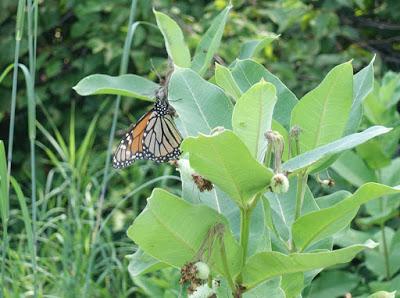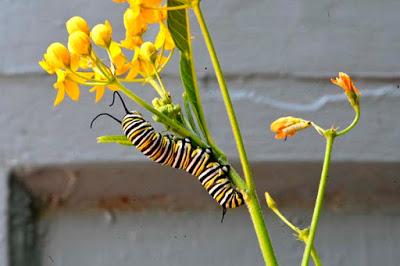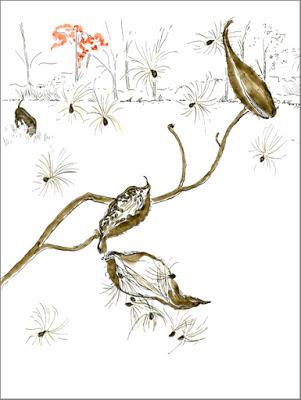
Monarch butterfly on a milkweed plant in northern Wisconsin.
Look along a roadside, in a vacant lot, or in an abandoned country field, and you will probably see milkweed, a tall plant with broad leaves, thick stems and pink, yellow or purple flowers. If you look closely, you might find a monarch butterfly sipping nectar. Many insects make milkweed plants their home. They eat the nectar, sap, leaves, stems, roots, and seeds. You may also have milkweed plants, also called butterfly weed, in your garden.
Monarch caterpillar on a milkweed plant in my garden.
Milkweed gets its name from the white sap inside its stem. Poisonous chemicals are in the sap. Most plant-eating animals, such as cattle or deer, do not eat milkweed because it tastes bad. But monarch butterfly caterpillars are able to eat milkweed sap and the poison does not hurt them. A little bit of the poison becomes part of their bodies and helps protect them from birds and other predators. Predators learn to recognize monarchs by their distinctive black and orange colors and avoid them because they taste bad.Female monarchs lay their eggs on milkweed leaves and when the eggs hatch, the tiny caterpillars eat the leaves. After a few weeks, when the caterpillars are about two inches long, they stop eating, attach themselves to a leaf and cover themselves with a green shell called a chrysalis. Inside, the chrysalis, the caterpillar, now called a pupa, slowly transforms into a butterfly. After about two weeks, the beautiful butterfly emerges and the cycle of life begins again. (For a previous post with more about metamorphosis and a photo of a monarch chrysalis, click HERE.)

Milkweed pods in the fall. (Illustration by Caroline Arnold)
In the fall, monarch butterflies fly to their winter homes and milkweed flowers turn into seed pods. At first, the crescent shaped pods are soft and green. As the seeds grow inside the pod, the outside becomes hard and brown. When the seeds are ripe, the pod cracks open and the seeds spill out. The wind catches the the fluffy seeds and they are carried away, floating like tiny helicopters. Some of the seeds fall to the ground. In the following spring they will grow into new milkweed plants, providing homes for a new generation of monarchs.Monarch butterflies depend on milkweed. In recent years, the disappearance of milkweed in many rural areas as a result of development has had a deleterious effect on monarch butterflies and their numbers have plummeted. You can learn about planting milkweed in your area to help monarch butterflies at this NWF website.
In my book, Butterflies in Room 6, about a kindergarten class raising painted lady butterflies, you can learn more about butterfly development.
